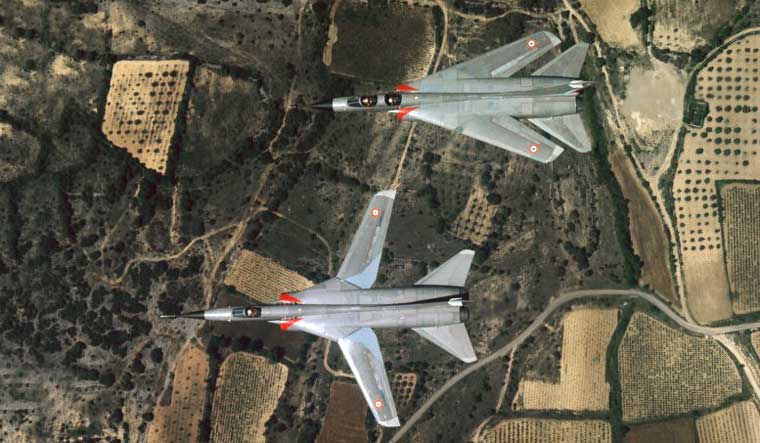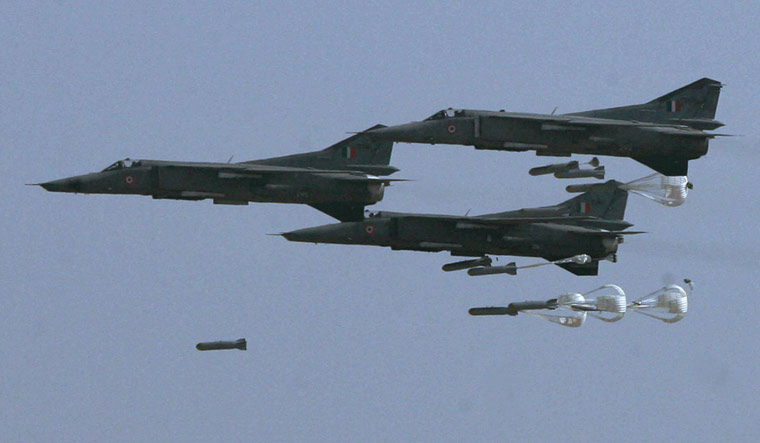The MiG-27 fighters of the Indian Air Force will be retired at a ceremony at the Jodhpur airbase on December 27. The event marks not just the retirement of another aircraft type from the Indian Air Force, but the end of the use of a technology, that, for about a decade, dominated military aviation.
This technology was ‘variable sweep’ wing design, more commonly known as ‘swing wing’. Aircraft with swing wing technology could sweep their wings forward or backward to optimise performance at take-off and landing and for high-speed flight. At the height of the Cold War in the 1960s, swing wing technology seemed to be the dominant theme in military aviation; its importance was akin to that of stealth technology in the 1990s.
Swing wing technology attempted to solve the problem of rapidly growing weight of aircraft by allowing the aircraft to, effectively, change its shape in flight. Sweeping the wings straight gave the aircraft design maximum lift, allowing for shorter take-off and landing runs, while maximising weapons load. Sweeping the wings backward reduced the drag in flight, improving speed, and allowed greater agility in aerial combat.
 Two Mirage G8 fighters show how swing wing aircraft operate: The aircraft on top has its wings swept backward and one below has wings swept forward | Dassault Aviation
Two Mirage G8 fighters show how swing wing aircraft operate: The aircraft on top has its wings swept backward and one below has wings swept forward | Dassault Aviation
Like all forms of technology during the Cold War, research and development in swing wing aircraft saw considerable competition between the Soviet Union and the US. In 1967, the US Air Force inducted the first production swing wing aircraft, the F-111, which was a strike aircraft. The F-111, which was the brainchild of John F. Kennedy’s defence secretary Robert McNamara, had suffered a torturous development. Critics bristled at teething troubles with the aircraft, calling it ‘McNamara’s Folly’. However, the F-111 went on to serve as a capable strike aircraft, seeing service over Vietnam, the 1991 Kuwait War and, most famously, the US attack over Libya in 1986.
1967 proved to be a key year for swing wing aircraft as the first Soviet fighter equipped with the technology flew for the first time that year. This was the MiG-23. The MiG-23 was designed to be the replacement for the then standard MiG-21, which suffered from poor range and limited radar and weapons capability.
The MiG-23 was also the first swing-wing aircraft to enter service with the Indian Air Force, joining service in 1980. The MiG-23 was the first fighter in the Indian Air Force to be equipped with beyond-visual-range radar-guided air-to-air missiles and a ‘look-down/shoot-down’ radar, which could pick up low-flying targets. Approximately 150 MiG-23 fighters were inducted into the Indian Air Force.
The Indian Air Force also used the MiG-23 in a ground-attack role in the Kargil war.
The MiG-27 was a specialised ground-attack variant of the MiG-23. The most visible difference between the MiG-23 and MiG-27 was the latter substituted the nose-mounted radar of the MiG-23 with a laser and optical targeting system for guiding air-to-ground bombs and missiles. HAL was given a contract to build 165 MiG-27 fighters for the Indian Air Force.
Swing wing technology was such a rage in the 1960s that some designers saw it as the answer to all woes and as a means to improve existing designs.
The Soviet Union, in fact, created the Su-17, a swing-wing variant of the Su-7 ground-attack fighter, which had suffered from poor range and weapons carriage capability. The Su-7, incidentally, was used by the Indian Air Force in the 1971 Bangladesh War. Another such swing wing conversion was the Tu-22M ‘Backfire’ bomber, which was derived from the older Tu-22 bomber. The Russian military continues to operate the Tu-22M, which can carry long-range cruise missiles for striking ships and land targets.
Despite its appeal, swing wing technology had drawbacks. The additional movable parts on the wing greatly increased weight and made aircraft hydraulics complex, contributing to higher maintenance and operating costs. Moreover, the advent of ‘fly by wire’ flight controls (that used computers to control the aircraft), light-weight composite material for building parts and advances in wing design by the 1970s negated the need for swing wing aircraft.
The MiG-23 and MiG-27 also had poor safety records. In 2002, a Public Accounts Committee report to Parliament on the MiG-21’s safety record argued the MiG-21 had a better safety record than the MiG-23 and MiG-27. The MiG-27 also saw lukewarm export success, being operated by India and Sri Lanka.
The Indian Air Force retired its MiG-23 fleet in 2009-2010, meaning the MiG-21 has outlived the aircraft once intended to replace it.
also read
- IAF commanders to discuss ‘Gagan Shakti’ lessons in apex four-day meet
- How induction of 56 C-295 military aircraft will make Indian Air Force more deadly and agile
- IN PICS | Chennai IAF airshow: How bad was the crowd, traffic at Marina Beach as 5 dead, Velachery railway station crowded?
- Chennai IAF airshow: What happened at Marina beach as 5 dead, Velachery railway station crowded?
- Tarang Shakti: ‘India's aim is to unite, move forward together with other nations’, says Defence Min Rajnath Singh
Swing wing fighters remain in service in various countries, but in declining numbers. The UK’s Royal Air Force retired its fleet of Panavia Tornado strike aircraft this year after 40 years of service. However, swing wing bombers are still popular, with the US Air Force operating the B-1 and Russia using the Tu-160 and Tu-22M.
PS: Since 2000, there have been news reports claiming the Indian Navy could lease Tu-22M bombers from Russia. While there is little evidence to prove such a lease has happened, the Tu-22M would have proved a potent aircraft to carry forward India’s legacy of swing wing aircraft!


